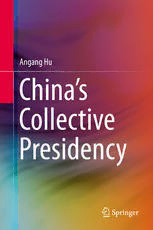
China’s Collective Presidency PDF
Preview China’s Collective Presidency
Angang Hu China’s Collective Presidency China’s Collective Presidency Angang Hu China’s Collective Presidency 123 AngangHu SchoolofPublicPolicyandManagement TsinghuaUniversity Beijing,Beijing,China ISBN978-3-642-55278-6 ISBN978-3-642-55279-3(eBook) DOI10.1007/978-3-642-55279-3 SpringerHeidelbergNewYorkDordrechtLondon LibraryofCongressControlNumber:2014938484 ©Springer-VerlagBerlinHeidelberg2014 Thisworkissubjecttocopyright.AllrightsarereservedbythePublisher,whetherthewholeorpartof thematerialisconcerned,specificallytherightsoftranslation,reprinting,reuseofillustrations,recitation, broadcasting,reproductiononmicrofilmsorinanyotherphysicalway,andtransmissionorinformation storageandretrieval,electronicadaptation,computersoftware,orbysimilarordissimilarmethodology nowknownorhereafterdeveloped.Exemptedfromthislegalreservationarebriefexcerptsinconnection with reviews or scholarly analysis or material supplied specifically for the purpose of being entered and executed on a computer system, for exclusive use by the purchaser of the work. Duplication of this publication or parts thereof is permitted only under the provisions of the Copyright Law of the Publisher’slocation,initscurrentversion,andpermissionforusemustalwaysbeobtainedfromSpringer. PermissionsforusemaybeobtainedthroughRightsLinkattheCopyrightClearanceCenter.Violations areliabletoprosecutionundertherespectiveCopyrightLaw. Theuseofgeneraldescriptivenames,registerednames,trademarks,servicemarks,etc.inthispublication doesnotimply,evenintheabsenceofaspecificstatement,thatsuchnamesareexemptfromtherelevant protectivelawsandregulationsandthereforefreeforgeneraluse. While the advice and information in this book are believed to be true and accurate at the date of publication,neithertheauthorsnortheeditorsnorthepublishercanacceptanylegalresponsibilityfor anyerrorsoromissionsthatmaybemade.Thepublishermakesnowarranty,expressorimplied,with respecttothematerialcontainedherein. Printedonacid-freepaper SpringerispartofSpringerScience+BusinessMedia(www.springer.com) Contents 1 Introduction—KeytotheSuccessofChina’sPoliticalSystem ......... 1 1.1 TheWaytoSuccessforChina.......................................... 2 1.2 TheRiseoftheCollectivePresidency ................................. 5 1.3 CharacteristicsoftheCollectivePresidency........................... 7 1.4 FrameworkforanAnalysisoftheCollectivePresidency............. 8 1.5 TheFundamentalFeaturesoftheCollectivePresidency.............. 9 References..................................................................... 12 2 TheHistoricalDevelopmentoftheCollectivePresidencyinChina.... 15 2.1 PhaseofEmergence(1927–1948)...................................... 15 2.2 PhaseofEstablishment(1949–1957).................................. 18 2.3 PhaseofSeriousDamage(1958–1976)................................ 21 2.4 PhaseofRecoveryandReconstruction(1977–1991)................. 27 2.5 PhaseofConsolidationandOptimization(1992–2012) .............. 33 References..................................................................... 38 3 CollectiveDivisionofWorkandCooperation ............................ 41 3.1 TheHistoricalDevelopmentofCollectiveCollaboration............. 41 3.2 HowtheSystemofCollaborationandDivisionofWorkOperates... 45 3.3 EvaluatingtheSystemofCollaborationandDivisionofWork....... 51 References..................................................................... 53 4 TheCollectiveHandoverProcedure....................................... 55 4.1 TheHistoricalDevelopmentoftheCollective HandoverProcedure .................................................... 55 4.2 HowtheCollectiveHandoverWorks .................................. 59 4.3 EvaluatingtheCollectiveHandoverProcedure........................ 69 References..................................................................... 72 v vi Contents 5 CollectiveLearning.......................................................... 73 5.1 TheHistoryofCollectiveLearning.................................... 73 5.2 HowCollectiveLearningWorks ....................................... 75 5.3 CommentsonCollectiveLearning..................................... 78 References..................................................................... 79 6 CollectiveResearch.......................................................... 81 6.1 TheHistoricalDevelopmentofCollectiveResearch.................. 81 6.2 HowCollectiveResearchWorks....................................... 85 6.3 EvaluatingthePracticeofCollectiveResearch........................ 96 References..................................................................... 98 7 CollectiveDecisionMaking................................................. 101 7.1 TheHistoricalDevelopmentofCollectiveDecisionMaking......... 101 7.2 HowCollectiveDecisionMakingWorks.............................. 105 7.3 EvaluatingthePracticeofCollectiveDecisionMaking............... 109 References..................................................................... 111 8 PoliticalAdvantagesoftheCollectivePresidency........................ 113 8.1 TheDevelopmentoftheCollectivePresidency ....................... 114 8.2 TheCreativityoftheCollectivePresidency ........................... 118 8.3 TheInternationalCompetitivenessoftheCollectivePresidency..... 123 8.4 ConstantlyImprovingtheCollectivePresidency...................... 128 8.5 Conclusion:AStableandInvincibleChina............................ 134 References..................................................................... 135 Appendices........................................................................ 137 Appendix1:ListofMembersoftheStandingCommittee ofthePoliticalBureauoftheCentralCommitteeoftheCPC (1927–2011)................................................................... 137 Appendix2: Division of Work Among Membersof the StandingCommitteeofthePoliticalBureauoftheCentral CPCCommitteefromtheTwelfthtoFifteenthNationalCongresses....... 140 Postscript.......................................................................... 145 References..................................................................... 156 Chapter 1 Introduction—Key to the Success of China’s Political System IfirstaddressedthewholeStandingCommitteeofthePoliticalBureauoftheCentral CommitteeoftheCommunistPartyofChina(CPC)intheautumnof2007.Istated thattheStandingCommitteehadbroughtaboutascientificapproachtodevelopment and established a governingphilosophycharacterized by harmony.I noted that in thisway,theStandingCommitteehadturnedoveranewpageinChinesesocialism, andthatitseffortswereacknowledgedandsupportedbyallCPCmembers,allthe servicemen and women of the People’s Liberation Army, and the Chinese people asawhole.Further,theseeffortshadwonglobalattentionandbeenapplaudedthe worldover.I also asked a seriesof importantquestions.How shouldtheStanding CommitteeofthePoliticalBureauberunpolitically?HowshouldagoodStanding Committeebeensured?ThroughwhatkindsofprocessesdoestheCommitteereach its decisions?Accordingto whatstandardsdoesit operate?Whatmechanismsare inplaceto ensurethatthecommitteemakesthecorrectmajordecisions?(Angang Hu2007b). In this regard,I am in agreementwith Deng Xiaoping. He said that the key to dealingwithChina’sproblemsisforChina(theCPC)tohaveacompetentPolitical Bureau,andespeciallyacompetentStandingCommittee.Chinawillenjoystability ifthiscompetencycanbeassured(XiaopingDeng1993). In an article I wrote in the spring of 2008, I identified the most important politicalfactorsthathadledtothesuccessthatChinahasexperienced(AngangHu 2008a).TheuniqueinnovationsintroducedbytheCPCanditsincreasingmaturity inpoliticalmattershaveproducedastablesocietyandgeneratedtheconditionsthat haveenabledsteadyeconomicgrowth.Thebiggestchallengethatmanydeveloping countries around the world face is the lack of a scientifically based, efficient decision-makingmechanismfordealingwithmajorproblems.Becauseofthis,they areunabletoachieveastablesocietyandeconomicgrowth.Thesuccessdisplayed bytheChinesegovernmentincopingwiththeglobalfinancialcrisisfromthesecond halfof2008totheendof2010underlinestheimportanceofsuchdecision-making mechanisms. OnJanuary17,2011,PresidentHuJintaowasacceptingwritteninterviewsfrom theAmericanmediaontheeveofhisvisittotheUnitedStates,thepartialpurpose A.Hu,China’sCollectivePresidency,DOI10.1007/978-3-642-55279-3__1, 1 ©Springer-VerlagBerlinHeidelberg2014 2 1 Introduction—KeytotheSuccessofChina’sPoliticalSystem ofwhichwastohelpclarifycertaindoubtsthattheWesthadlongheldwithrespect toChina.Atthattime,Huclearlypointedout,“ThefactthatChinahasmaintained rapideconomicdevelopmentandachievedaharmonious,stablesocietyoveralong period is evidence of the fact that China’s political system currently conforms to the actual needs of China’s economy and society, and it has been able to adapt overall to the requirements of social development.”1 The speech emphasized that China’spoliticalsystemisbothappropriateandadaptable,anditalsopointedtothe rationalityandsuitabilityofitsinstitutions. On July 1 of the same year, in a speech at a conference celebrating the 90th anniversary of the founding of the CPC, Hu pointed out that the Chinese version ofsocialismwaswhatwouldinthelongrunguaranteethefuturedevelopmentand progressof China. He also reflected on the featuresand advantagesthatthis form ofsocialismoffered.HuconcludedhisaddressbynotinghowtheNationalPeople’s Congress is the foundationalpolitical institution in China and is characterized by multi-party cooperation and political consultation, led by the CPC and working throughregionalethnicautonomyandgrassrootsautonomy(JintaoHu2011). ThisspeechincreasedtheconfidenceofCPC membersandthe Chinesepeople intheirpoliticalinstitutions.IthighlightedhowsocialisminChina,andthepolitical systeminparticular,hasbeenkeyforthecountry’scontinuedsuccessinthefaceof internationalcompetition. 1.1 TheWaytoSuccess for China Thereis no one idealpoliticalsystem in the extremelycomplicatedworld we live in today,and it is impossible to see one emergingin the light of constantchange. Politicalsystemsaredividedintovarioustypes.Howareweabletojudgewhichis themostappropriate?Thisisamatterthatshouldnotrelyonsubjectiveappraisal; neither should it be addressed purely in terms of standard Western values. It is necessary to conduct an analysis based on the background details relating to a specificcase,usequantifieddata,andemployobjectivefacts(AngangHu2011). Deng Xiaoping pointed out that the goals of socialist modernization and con- struction in China should include the following: catching up with developed capitalistcountries;creatingamoreadvanced,morepracticaldemocracythanthat existing in those capitalist countries; and cultivating better human resources than theonesin suchcountries.Thetimetakentoachieveeachofthesegoalscouldbe relatively long or short. However, as a large socialist country, it is necessary for Chinatoreachthesegoals.Thus,itisnecessarytoexaminethebestfeaturesofthe variousinstitutionsthatoperateinconjunctionwiththeCPCandtheChinesestate andassesswhetherornottheyaretakingChinatowardsthosegoals(XiaopingDeng 1994a). 1Xinhuanet.com(2011).TheAmericanmediawereTheWallStreetJournalandWashingtonPost. 1.1 TheWaytoSuccessforChina 3 I define the above three goals as “Deng Xiaoping’s standards” and also as “China’sstandards.”InassessingChina’spoliticalinstitutions,itisnotappropriate to use the standards of Soviet Russia or those of the United States. Analyzing the situation in China and comparing China with other countries should be done using China’s or Deng Xiaoping’s standards. It is particularly important to make comparisonswiththeUnitedStatesbecauseChinahasthepopulationandresources to catch up with and eventually exceed the United States. China’s population is four to five times larger than that of the United States, and its vast territory, rich in resources, is equal in size to that of the United States. However, if China possessed only the required population and resources without the appropriate politicalinstitutions,aswasthecasewiththeKuomintanggovernmentuntil1949, China wouldsimply be relegatedto beinga dependencyof the United States, and theeconomicgapbetweenthetwocountrieswouldbecomeeverwider. ChinacanachieveitsgoalofcatchingupwithandsurpassingtheUnitedStates only if the appropriate conditions exist in the country. Over the past century, Chinalaggedbehindthemostdevelopedcapitalistcountries,particularlytheUnited States, in terms of industrialization,urbanization,and modernization.Fortunately, socialism was established, and this led to China becoming a rival of the United States that will one day surpass it. The reason for China having risen to become a challenger to the United States is its superior political system—socialism. That systemhasbeenresponsibleforrevitalizingChina. CatchingupwithandsurpassingtheUnitedStateshasalwaysbeenanimportant strategicgoalforChina,asMaoZedongstatedin1956.2InfluencedbyMao,Ihave arguedthatChinashouldcatchupwiththeUnitedStatesinthetwenty-firstcentury atamuchfasterpace.3 Itisappropriateatthispointtoexaminethedataandassessthepracticaleffects overthe30yearssinceDengXiaoping’sstandardswereintroduced. First, China’s economy is second in size to that of the United States, and one daywillexceedit. Accordingto GDPdataprovidedbyAngusMaddisoninterms ofpurchasingpowerparity(PPP)withtheinternationalvalueoftheU.S.dollarin 2DuringthePreparatoryMeetingofthe8thCPCNationalCongress,MaoZedongstatedthatthe goalwastocatchupwithandsurpasstheUnitedStatesin50or60years,“Chinashouldcatchup withthemostpowerfulcapitalistcountryintheworld—theUnitedStates.TheUnitedStateshas apopulationofjust170million,butChina’spopulationismanytimesthat,andChinahasrich resourcesandasimilarclimate.Soitispossibletocatchupwithit.Shouldwecatchupwithit?Of courseweshould.Weshouldcompletelysurpassitafter50[2006]to60years[2016]”.SeeMao Zedong’s(1999a). 3In a National Situation Report in 2000 I set out the future development objectives for China at the start of the new century. The main objective should be to continue catching up with developedcountriesandnarrowingthegapwiththosecountries,intermsofthestandardindicators of modernization. In fact China should close the gap with the United States at a faster rate. Adevelopingcountrywiththelargestpopulationintheworldisboundtocatchupwiththemost advancedandmostpowerfulcountryintheworld.Thatwillconstituteaverysignificanteventand willhaveagreatimpactonthecourseofhumandevelopmentinthetwenty-firstcentury.SeeHu Angang’s(2000).
